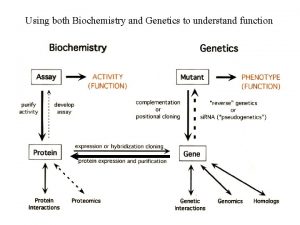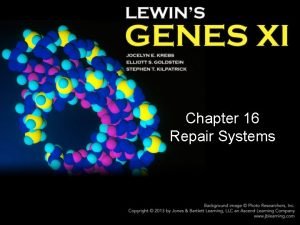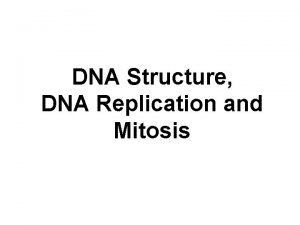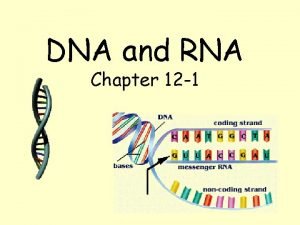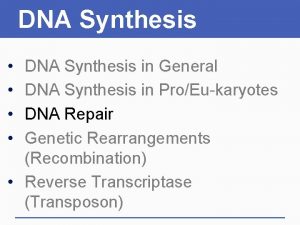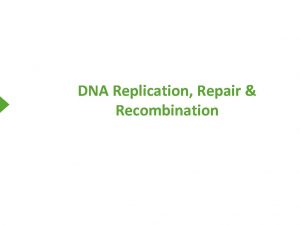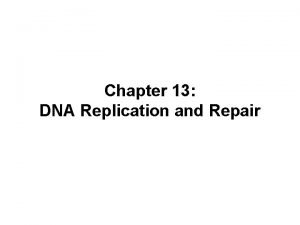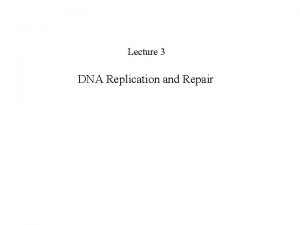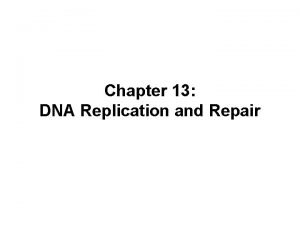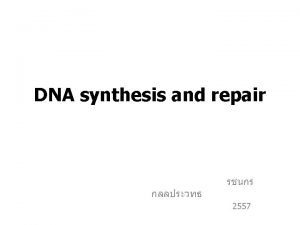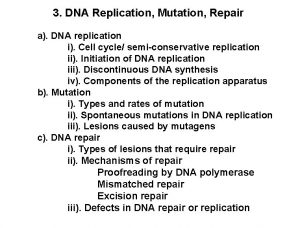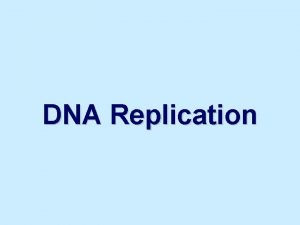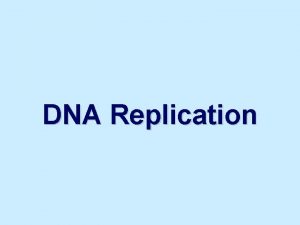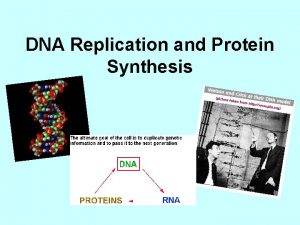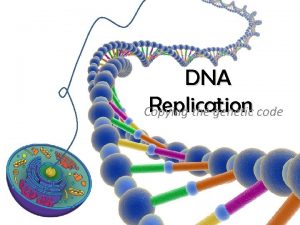DNA Genetic Information Replication and Repair Replication Synthesis




















- Slides: 20

DNA: Genetic Information, Replication, and Repair

Replication: Synthesis of a daughter duplex DNA molecule identical to the parental duplex DNA replication is governed by a set of fundamental rules: - DNA replication is semiconservative - Replication begins at an origin and usually proceeds bidirectionally - DNA synthesis proceeds in a 5'→ 3' direction and is semidzseonttnuous

DNA Replication Requires Many Enzymes and Protein Factors 1. Dna. A protein: a complex of about 20 Dna. A protein molecules that recognizes and successively denatures the DNA in the region, which are rich in A=T pairs. 2. Helicase ( DNA B protein): an enzyme that catalyzes the separation of strands in a DNA molecule before replication. 3. Topoisomerases: Enzymes that introduce positive or negative supercoils in closed, circular duplex DNA. 4. Primase: An enzyme that catalyzes the formation of RNA oligonucleotides used as primers by DNA polymerases. 5. DNA polymerase: An enzyme that catalyzes template-dependent synthesis of DNA from its deoxyribonucleoside 5'-triphosphate precursors. 6. DNA ligase: An enzyme that creates a phosphodiester bond between the 3' end of one DNA segment and the 5' end of another.

DNA Replication Is Semiconservative The mechanism for DNA replication is strand separation followed by the copying of each strand. In the process, each separated strand acts as a template for the synthesis of a new complementary strand whose nucleotide sequence is fixed by the base -pairing rules. Strand separation is achieved by untwisting the double helix. Base pairing then dictates an accurate replication of the original DNA double helix.

In 1958, Matthew Meselson and Franklin Stahl provided the experimental proof for the semiconservative model of DNA replication.

Replication Is Bidirectional Replication of DNA molecules begins at one or more unique sites called origin(s) of replication. Bidirectional replication involves two replication forks, which move in opposite directions. Unwinding the DNA Helix Semiconservative replication depends on unwinding the DNA double helix to expose single-stranded templates to polymerase action.

DNA Synthesis Proceeds in a 5'→ 3' Direction Replication is semidiscontinuous: because DNA polymerases only polymerize nucleotides 5'→ 3', both strands must be synthesized in the 5'→ 3' direction.

Thus, the copy of the parental 3 '→ 5' strand is synthesized continuously; this newly made strand is designated the leading strand. As the helix unwinds, the The Lagging Strand Is Formed from Okazaki other parental strand (the Fragments 5'→ 3' strand) is copied in a discontinuous fashion through synthesis of a series of fragments 1000 to 2000 nucleotides in length, called the Okazaki fragments; the strand constructed from the Okazaki fragments is called the lagging strand. An electron micrograph of DNA replication

DNA Ligase DNA ligase seals nicks in double-stranded DNA where a 3'OH and a 5'-phosphate are juxtaposed. This enzyme is responsible for joining Okazaki fragments together to make the lagging strand a covalently contiguous polynucleotide chain.

DNA Polymerases—The Enzymes of DNA Replication The search for an enzyme that could synthesize DNA was initiated in 1955 by Arthur Kornberg and colleagues. This work led to the purification and characterization of DNA polymerase from E. coli cells, a singlepolypeptide enzyme now called DNA polymerase I (Mr 103, 000).

Most cells have several DNA polymerases In E. coli, DNA polymerase III is the primary replication enzyme. DNA polymerase I is responsible for special functions during replication, recombination, and repair. DNA polymerase II has a specialized replication activity that allows it to replicate past DNA lesions in errorprone DNA repair. Ribbon diagram of the b subunit dimer of the DNA polymerase III holoenzyme on B-DNA Space-filling model of the b subunit dimer of the DNA polymerase III holoenzyme on BDNA.

Bond Formation in DNA Replication

Topoisomerases The progression of the replication fork requires that the DNA ahead of the fork be continuously unwound. Due to the fact that eukaryotic chromosomal DNA is attached to a protein scaffold the progressive movement of the replication fork introduces severe torsional stress into. the duplex ahead of the fork. This torsional stress is relieved by DNA topoisomerases Topoisomerases relieve torsional stresses in duplexes of DNA by introducing either double- (topoisomerases II) or single-stranded (topoisomerases I) breaks into the backbone of the DNA. These breaks allow unwinding of the duplex and removal of the replication-induced torsional strain. The nicks are then resealed by the topoisomerases.

The DNA would become too tightly supercoiled to allow unwinding of the strands. DNA gyrase, a Type II topoisomerase, acts to overcome the torsional stress imposed upon unwinding by introducing negative supercoils at the expense of ATP hydrolysis.

General Features of a Replication Fork The DNA duplex is unwound by the action of helicase, and the single strands are coated with SSB (ss. DNA-binding protein). Primase periodically primes synthesis on the lagging strand. DNA polymerase I and DNA ligase act downstream on the lagging strand to remove RNA primers, replace them with DNA, and ligate the Okazaki fragments.

DNA replication must be highly accurate The free energies associated with base paring within the double helix suggest that approximately 1 in 104 bases incorporated will be incorrect. Yet, DNA replication has an error rate estimated to be 1 per 1010 nucleotides. Two fundamental types of molecular mechanisms for DNA repair can be distinguished: (a) mechanisms that excise and replace damaged regions by replication, recombination, or mismatch repair, and (b) mechanisms that reverse damaging chemical changes in DNA; the latter includes excision repair systems.

UV irradiation causes dimerization of adjacent thymine bases.



DNA Recombination
 Bioflix activity dna replication dna replication diagram
Bioflix activity dna replication dna replication diagram Chapter 11 dna and genes
Chapter 11 dna and genes Dna synthesis at replication fork
Dna synthesis at replication fork Replication fork
Replication fork Excision repair
Excision repair Base excision repair vs mismatch repair
Base excision repair vs mismatch repair Founder effect genetic drift
Founder effect genetic drift Genetic programming vs genetic algorithm
Genetic programming vs genetic algorithm Genetic programming vs genetic algorithm
Genetic programming vs genetic algorithm Genetic drift vs gene flow
Genetic drift vs gene flow What is the difference between genetic drift and gene flow
What is the difference between genetic drift and gene flow Whats primase
Whats primase Dna structure and replication pogil
Dna structure and replication pogil Dna structure and replication packet answer key
Dna structure and replication packet answer key Dna replication transcription and translation
Dna replication transcription and translation Dna replication
Dna replication Rna and protein synthesis study guide
Rna and protein synthesis study guide Chapter 12 section 1 dna the genetic material
Chapter 12 section 1 dna the genetic material Chapter 12 section 1: dna: the genetic material
Chapter 12 section 1: dna: the genetic material Chapter 12 section 1 dna the genetic material
Chapter 12 section 1 dna the genetic material Chapter 12 dna and rna section 12-1
Chapter 12 dna and rna section 12-1


